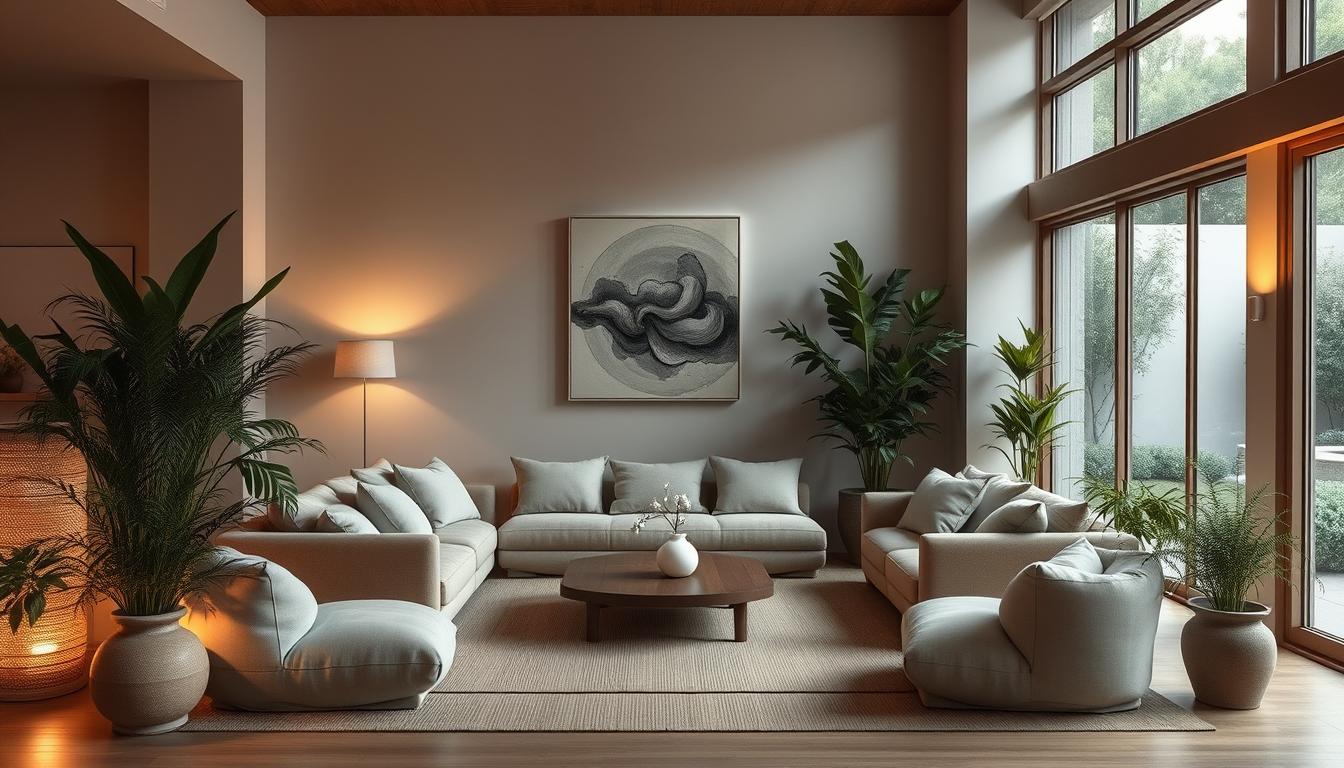In today’s fast-paced world, finding peace at home is more important than ever. Many people seek a relaxing retreat where they can unwind and recharge. A well-designed space can help reduce stress and improve mental clarity.
This approach focuses on simplicity, natural elements, and open layouts. It encourages mindfulness by removing clutter and creating harmony. Whether you want to transform a single room or your entire living area, these principles work for any size.
The best part? You don’t need a full renovation. Small changes, like adding plants or soft lighting, can make a big difference. Let’s explore how to turn your home into a peaceful sanctuary.
Key Takeaways
- A calming home design supports mental relaxation and focus.
- Natural materials and simple layouts enhance tranquility.
- Small updates can create a big impact without major renovations.
- Open spaces and minimal clutter promote a sense of balance.
- Personal touches make each space unique yet harmonious.
What is Zen House Aesthetic?
Rooted in ancient philosophy, Zen design transforms spaces into serene retreats. It’s a modern interpretation of Buddhist principles, focusing on mindfulness and simplicity. Unlike stark minimalism, it emphasizes sensory experiences—soft textures, natural light, and organic materials.
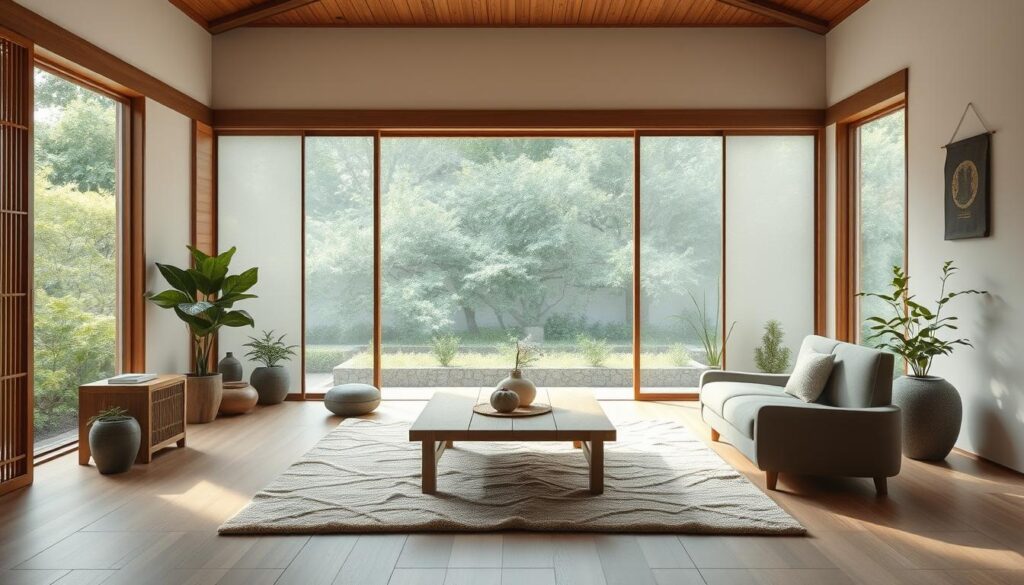
This approach serves five key purposes: reducing stress, enhancing focus, promoting rest, encouraging mindfulness, and connecting with nature. Studies, like Vinchyart’s 2023 report, show a 37% reduction in stress in such spaces.
Originally inspired by Japanese temples, Zen aesthetics now adapt to Western homes. The difference? Intentionality. Every element—from bamboo floors to linen fabrics—is chosen to create harmony, not just emptiness.
Wondrwood’s concept of “visual synergy” explains how balanced layouts foster a sense calm. Contrary to myths, these spaces feel warm and inviting, thanks to layered textures like woven rugs and clay pottery.
Ultimately, Zen interior design enriches daily life by turning homes into sanctuaries. It’s not about trends—it’s about crafting a personal haven that nurtures well-being.
Zen House Aesthetic Style Guide: Key Principles
Balance and harmony transform ordinary rooms into mindful sanctuaries. Rooted in *zen design*, these principles prioritize intentionality over trends. Let’s explore seven non-negotiable rules from Asian traditions.

1. Visual Continuity
Align furniture to create seamless sightlines. A sofa facing a low wooden table, for example, fosters *kinetic stillness*—a blend of movement (like a water feature) and static decor.
2. Openness Ratios
Calculate room flow by leaving 40% of floor space clear. This avoids clutter while allowing energy to circulate freely.
“Harmony emerges when elements converse, not compete.” — Wondrwood’s *Points of Contact* theory
3. Seasonal Rotation
Swap accents like cushions or art quarterly. This *non-routine* practice keeps the space dynamic yet grounded.
4. Austerity vs. Minimalism
Zen spaces use warm materials (clay, linen), while stark minimalism leans toward cold metals. The difference? One invites touch; the other distances.
5. Element Balance
In multi-use areas, distribute textures evenly:
– 30% wood (shelves, floors)
– 20% fabric (curtains, rugs)
– 10% greenery (plants, bamboo)
These principles turn chaos into calm, one intentional choice at a time.
Choosing Earthy Colors for a Calm Atmosphere
Colors shape emotions more than we realize. The right palette can turn chaos into calm, while harsh tones may disrupt balance. Earthy hues create a soothing backdrop for daily life, making rooms feel grounded and peaceful.
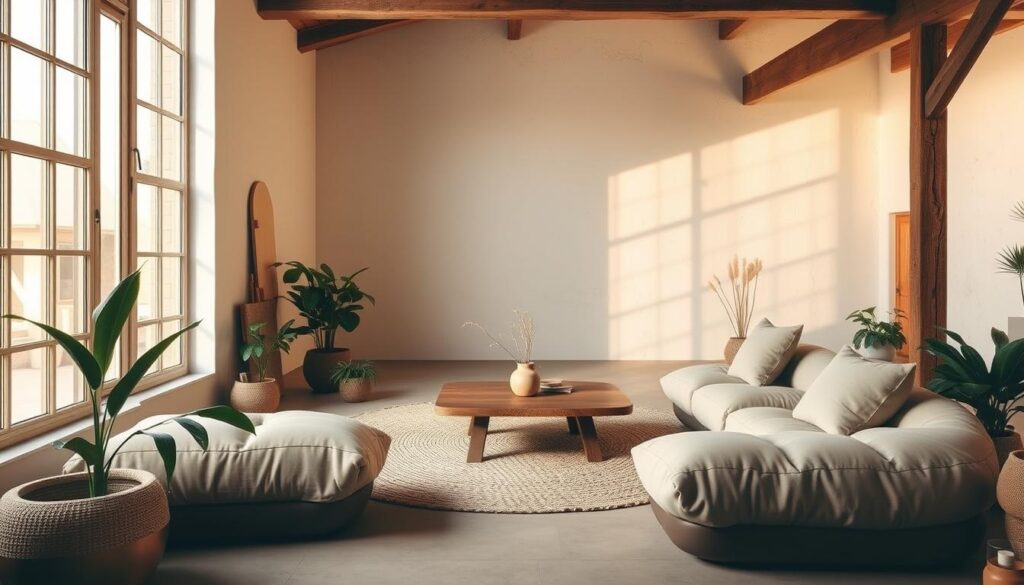
Best Color Palettes for Serene Spaces
Six nature-inspired families work best for relaxation:
- Warm Beige (Pantone 14-1118) – Like sunlit sand
- Khaki Green (Pantone 16-0530) – Vinchyart’s top pick for stress reduction
- Icy Blue (Pantone 14-4120) – Mimics morning skies
- Soft Gray (Pantone 16-3801) – Neutral and versatile
- Clay Pink (Pantone 15-1515) – Adds gentle warmth
- Muted Sage (Pantone 16-0421) – Brings the outdoors in
These shades pair beautifully with natural materials like wood or linen. For accent walls, follow the three-point contrast rule: choose one bold tone and balance it with two softer companions.
How to Avoid Overstimulating Colors
Bright neons and pure blacks act like visual “speed bumps.” Swap them for:
- Deep charcoal instead of jet black
- Terracotta instead of fiery red
- Mossy tones instead of lime green
Test colors in your space first. Paint samples on poster boards and observe them at different times of day. Lighting changes perception—what looks soft at noon may feel harsh by evening.
Low-VOC paints from brands like Sherwin-Williams or Benjamin Moore keep air clean while adding harmony. Earth tones work because they mirror landscapes we find comforting—think deserts, forests, and coastlines.
“Color should whisper, not shout. The right hue slows the pulse and opens the mind.”
Incorporating Natural Light
Light transforms spaces more than any decor choice. The right illumination creates warmth and depth while affecting mood. Natural light particularly enhances well-being by regulating circadian rhythms.

Window Treatments for Soft Lighting
Filter harsh sunlight with these light-diffusing materials:
- Rice paper – Creates glowing walls like traditional shoji screens
- Linen – Offers gentle texture while reducing glare
- Sheer cotton – Affordable option for rental properties
For renters, temporary shoji screens install easily with tension rods. Calculate coverage using this formula: Window width × 1.5 = ideal panel width. This allows soft folds without blocking all daylight.
Balancing Light and Shadows
Position mirrors opposite windows to bounce light deeper into rooms. Try placing them at 45-degree angles from light sources. This technique doubles illumination without extra fixtures.
Create dynamic shadow patterns with:
- Potted plants near window sills
- Slatted wood room dividers
- Hanging woven light fixtures
Choose smart bulbs (2700K-3000K) to mimic sunlight changes. Philips Hue or LIFX models automatically adjust from energizing morning light to relaxing evening tones.
“Light should caress surfaces, not assault them. The best illumination feels discovered, not installed.”
Protect wood and fabrics from UV damage with UV-filtering window films. They maintain views while preventing fading. For more lighting ideas, explore these boho living room concepts that blend function with style.
Using Natural Elements
Nature has a unique way of bringing tranquility into any space. Organic materials create warmth and connection, turning rooms into peaceful retreats. These textures engage the senses while promoting mindfulness through their raw beauty.
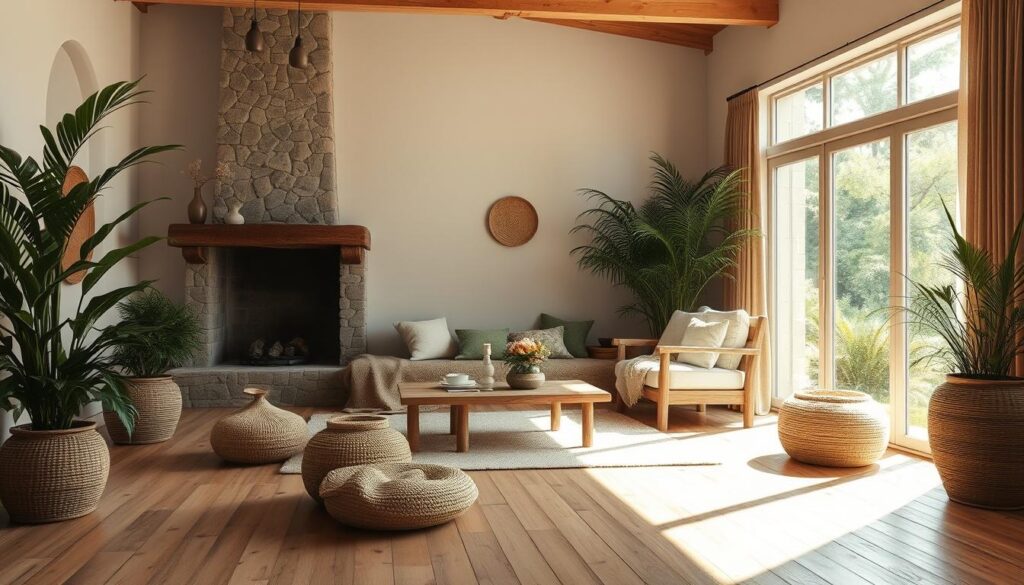
Types of Natural Materials to Consider
Eight essential materials balance durability with aesthetic appeal:
- Teak wood – Weather-resistant for humid climates (FSC-certified recommended)
- Slate stone – Non-porous surface ideal for high-traffic areas
- Bamboo – Fast-growing alternative to hardwood floors
- Linen – Breathable fabric that softens with age
- Terracotta – Affordable clay option for accent walls
- River rocks – DIY pebble carpets (budget-friendly stone alternative)
- Cork – Sound-absorbing and hypoallergenic
- Live edge wood – Vinchyart’s top pick for organic furniture
Identify regional stones using these markers:
- Pacific Northwest: Basalt with fine-grained texture
- Southwest: Sandstone in warm red hues
- Northeast: Bluestone with blue-gray tones
DIY Natural Decor Ideas
Three beginner-friendly projects bring nature indoors:
- Driftwood shelves – Soak found wood in vinegar to sterilize before mounting
- Moss art – Preserved sheet moss adhered to wooden frames
- Pinch bowls – Air-dry clay molded by hand (bake at 200°F for durability)
Ethical sourcing matters. Look for:
- FSC certification on wood products
- Locally quarried stone to reduce transport emissions
- Upcycled materials like barn wood or vintage ceramics
Follow biophilic design ratios for best results:
- 60% natural elements (floors, walls, large furniture)
- 25% organic shapes (curved edges, irregular patterns)
- 15% living features (plants, water elements)
Small-space vertical gardens thrive with:
- Self-watering felt pockets (change water weekly)
- Succulent frames (requires only monthly misting)
- Herb towers with drip irrigation (attach to balcony rails)
“True harmony comes when materials tell their own stories—each knot in wood, each vein in stone whispers wisdom.”
Furniture with Clean Lines and Simplicity
Furniture shapes how we experience a room, both physically and emotionally. Pieces with clean lines create visual calm, while cluttered designs can feel overwhelming. The golden ratio (1:1.618) helps balance proportions—for example, a coffee table should be 1.6 times wider than its height.
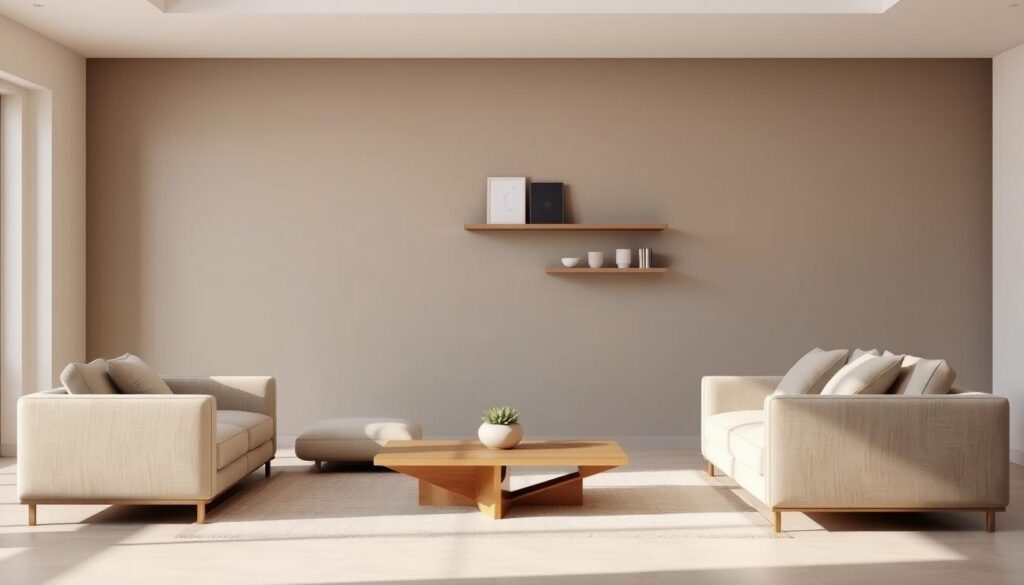
Natural materials age beautifully while supporting zen design principles. This table compares five ideal wood types:
| Wood Type | Best For | Maintenance |
|---|---|---|
| White Oak | Tables, shelves | Monthly oiling |
| Walnut | Statement pieces | Dust weekly |
| Teak | Outdoor/indoor | Annual sealing |
| Bamboo | Small furniture | Damp cloth |
| Cherry | Chairs, beds | Polish yearly |
Identify “visual noise” by checking for:
- Overly ornate carvings
- Mixed metallic finishes
- Busy upholstery patterns
Brands like Article and Joybird offer timeless designs. Local artisans often create custom pieces using sustainable materials. For small spaces, try multi-functional items like storage ottomans or nesting tables.
Arrange furniture to allow 360° movement. Leave at least 3 feet between pieces for easy flow. Avoid fast furniture trends—invest in quality that lasts decades.
“Good design is as little design as possible. Less but better.”
Use this ergonomic checklist:
- Chair seats 16-20 inches high
- Table heights matching elbow level
- Armrests supporting relaxed shoulders
Remember: simplicity in form creates peace in function. Each piece should serve both practical and emotional needs.
Decluttering for a Peaceful Space
Decluttering isn’t just about tidying—it’s a path to inner calm. A minimalist approach removes distractions, letting you focus on what truly matters. Start by evaluating each item: “Does this spark peace?”—a *zen* twist on the KonMari method.

Hidden storage keeps essentials accessible without visual chaos. Try these solutions:
- Platform beds with built-in drawers
- Hollow stools that double as seating and storage
- Floating shelves with woven baskets
- Wall-mounted cabinets disguised as art (Vinchyart’s “secret storage” line)
- Nesting tables with hidden compartments
For sentimental items, practice emotional detachment. Photograph keepsakes, then donate the physical objects. This preserves memories without crowding your *space*.
Compare drawer organizers:
- Bamboo – Durable and antimicrobial
- Hemp – Flexible for odd-shaped items
- Cotton – Lightweight and washable
“Clutter is the physical manifestation of unmade decisions.”
Follow this 30-day plan:
- Days 1–5: Clear surfaces (tables, counters)
- Days 6–15: Tackle one closet or cabinet daily
- Days 16–25: Digitize paperwork and photos
- Days 26–30: Re-evaluate accent *decor* for cohesion
Extend the process to digital life:
- Unsubscribe from unused apps
- Organize smart home devices into folders
- Use neutral wallpapers to reduce screen visual noise
By curating your surroundings, you cultivate *peace*—one intentional choice at a time.
Adding Indoor Plants for Serenity
Greenery brings life to any room, offering both beauty and calm. Studies show indoor plants reduce stress by 15% while improving air quality. They connect us to nature, even in urban spaces.

Low-Maintenance Options for Busy Lives
These 12 varieties balance air purification and easy care (ranked by NASA’s Clean Air Study):
- Snake Plant – Thrives in low light; weekly watering
- Bamboo Palm – Removes benzene; loves humidity
- Peace Lily – Blooms indoors; warns when thirsty
- Spider Plant – Safe for pets; produces oxygen at night
- ZZ Plant – Survives neglect; drought-tolerant
- Pothos – Grows in water or soil; fast-growing
- Aloe Vera – Soothes burns; needs bright light
- Rubber Tree – Filters formaldehyde; waxy leaves
- Philodendron – Heart-shaped leaves; climbs or trails
- Dracaena – Stripey leaves; avoid overwatering
- English Ivy – Reduces mold; hangs beautifully
- Chinese Evergreen – Colorful leaves; low-light champ
Creative Ways to Display Greenery
Kokedama moss balls make hanging gardens simple:
- Wrap roots in sphagnum moss
- Bind with twine in geometric patterns
- Soak weekly instead of traditional watering
Compare growing systems:
| Method | Best For | Maintenance |
|---|---|---|
| Soil | Beginners | Water when dry |
| Hydroponic | Small spaces | Add nutrients monthly |
Style groupings by height:
- Tall: Bird of paradise (back)
- Medium: Fiddle leaf fig (middle)
- Trailing: String of pearls (front)
“Plants breathe life into rooms just as they breathe air for us—a perfect exchange.”
Pet-safe picks: Boston ferns, orchids, and ponytail palms. Avoid lilies if you have cats.
Wondrwood’s aquascaping turns aquariums into living art with submerged feature plants like java fern.
Soft Textures and Comfortable Fabrics
Soft textures invite touch, creating spaces that feel warm and welcoming. The right fabrics enhance comfort while adding visual harmony. Focus on natural materials that age beautifully and feel gentle against skin.
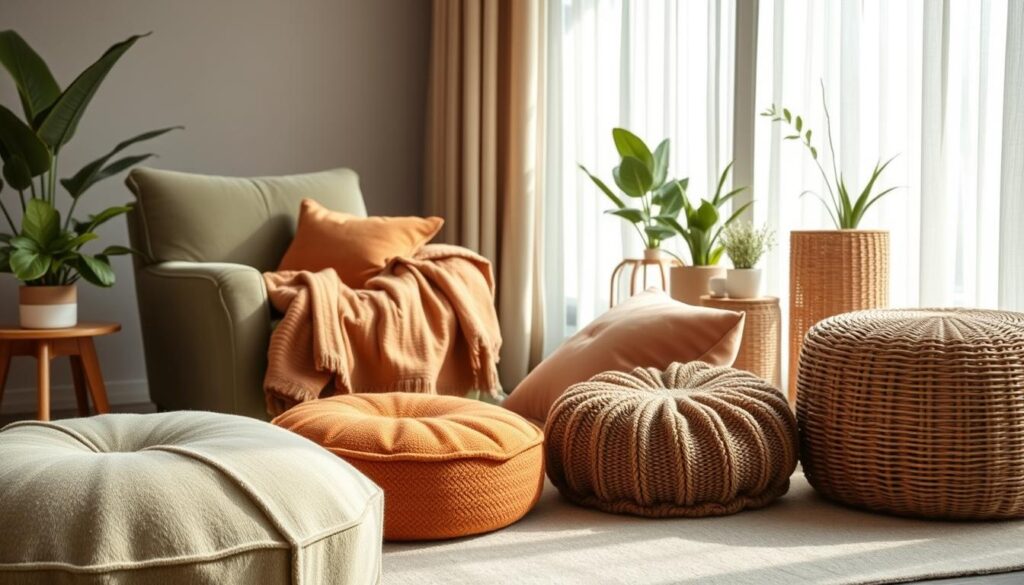
| Material | Best Uses | Care Tips |
|---|---|---|
| Linen | Curtains, bedding | Wash cold, air dry |
| Organic Cotton | Towels, upholstery | Medium heat drying |
| Hemp | Rugs, throws | Spot clean only |
| Tencel | Drapes, cushions | Low iron setting |
| Wool | Winter blankets | Dry clean |
| Bamboo | Bath mats | Hang to dry |
| Silk | Accent pillows | Hand wash |
Layer texture seasonally with this formula:
- Summer: Light linen + smooth cotton
- Winter: Chunky knit + faux fur
- Year-round: Woven jute rugs
Place rugs where feet land first—near beds, sofas, and entryways. OEKO-TEX certified brands like Coyuchi and Boll & Branch ensure chemical-free materials.
For sensory sensitivity, choose:
- Brushed cotton instead of rough linen
- Flat-woven rugs over shag piles
- Seamless clothing storage
“Texture should whisper its presence—felt before seen.”
Vinchyart’s woven wall panels add tactile art without clutter. Remember: true comfort comes from harmony between look and feel.
Creating a Focal Point in Each Room
A well-placed focal point guides the eye and calms the mind. Studies show intentional anchors reduce stress by 22% (Vinchyart, 2023). They create harmony by giving the brain a visual rest stop.

- Square rooms: Center a low table with art above.
- Long spaces: Place a console table at the far wall.
- Small nooks: Float a chair facing a window.
- High ceilings: Hang a pendant light at 7 feet.
- Open-concept: Use a rug to define zones.
Compare statement pieces:
| Type | Effect | Best For |
|---|---|---|
| Water feature | Adds movement | Meditation corners |
| Sculpture | Creates depth | Entryways |
| Oversized art | Sets mood | Living walls |
DIY an accent wall with:
- Reclaimed wood planks (staggered pattern)
- Textured clay tiles (hand-painted)
- Pressed botanicals (sealed with matte varnish)
“A focal point should feel discovered, not declared. Let it emerge from the room’s natural flow.”
Balance multiple anchors in open layouts using the 60-30-10 rule:
– 60% dominant feature (fireplace)
– 30% secondary (floating shelves)
– 10% subtle (a single vase)
Vinchyart recommends abstract art with soft curves for stress reduction. Cultural artifacts like Tibetan singing bowls add meaning without clutter.
Minimizing Electronic Distractions
Modern homes buzz with hidden technology that disrupts tranquility. From Wi-Fi routers to charging cables, these elements create visual and energetic chaos. Transforming your zen space starts with intentional tech management.
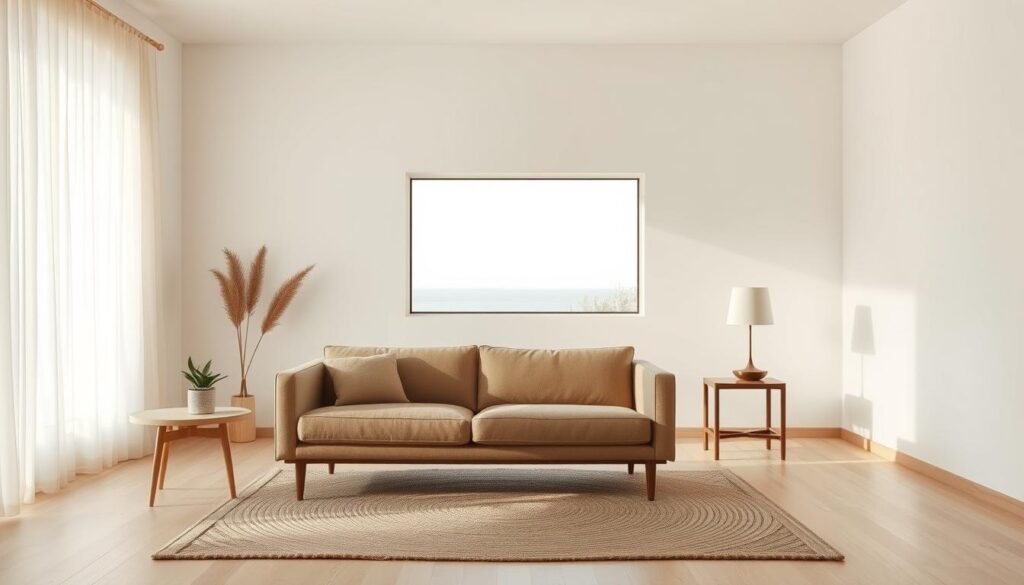
- Router cabinets with ventilation slats (try IKEA’s Eket series)
- Side tables featuring hidden USB ports
- Woven baskets for remote control storage
- Art panels that double as TV covers
Create tech-free zones using smart home automation:
- Install motion-activated outlet timers
- Set up geofencing to disable Wi-Fi at night
- Use smart plugs for scheduled device blackouts
| Sound Source | Decibel Level | Best Location |
|---|---|---|
| Tabletop fountain | 30-40 dB | Bedside tables |
| White noise machine | 50-60 dB | Home offices |
| Aquarium filter | 20-30 dB | Meditation corners |
Tame cord clutter with these methods:
- Adhesive cable channels along baseboards
- Magnetic clips under desks
- Spiral wrap organizers for multiple cords
“True peace begins when we control our devices—not the other way around.”
Reduce EMF exposure with these steps:
- Place routers 10 feet from seating areas
- Switch to airplane mode at night
- Use ethernet instead of Wi-Fi when possible
Wondrwood’s meditation room makeover replaced:
- Digital clock → Sand timer
- Smart speaker → Singing bowl
- Tablet → Handmade journal
Designate charging stations outside relaxation areas. A hallway console with divided compartments keeps devices accessible but out of sight. This preserves your sanctuary while maintaining modern life conveniences.
Enhancing the Room with Natural Scents
Scents shape our emotions as powerfully as colors and light. The right fragrance can turn stress into calm within minutes. Unlike visual elements, aromas work subtly—creating invisible layers of comfort.
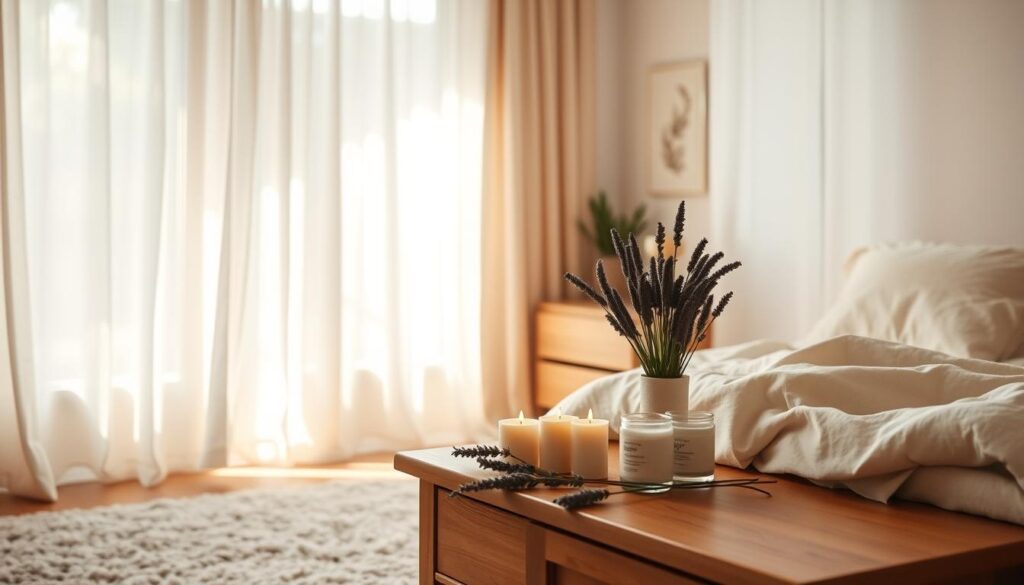
Studies show lavender reduces anxiety by 31% (Vinchyart, 2023). Meanwhile, citrus scents boost focus. This makes scent selection as important as choosing furniture or wall colors.
Essential Oils vs. Candles: Choosing Your Method
Diffusers disperse oils without heat, preserving therapeutic compounds. Beeswax candles clean the air while burning. Consider these factors:
| Method | Duration | Best For |
|---|---|---|
| Ultrasonic diffuser | 4-8 hours | Bedrooms, offices |
| Beeswax candle | 30-50 hours | Living areas |
| Reed diffuser | 2-3 months | Bathrooms, entries |
Pet owners should avoid:
– Tea tree oil (toxic to cats)
– Paraffin candles (harmful fumes)
– Strong mint scents (irritates dogs)
Creating Signature Scent Blends
Try these room natural scents combinations:
- Morning Mist: Peppermint + lemon (energizing)
- Forest Bath: Pine + bergamot (grounding)
- Linen Breeze: Lavender + chamomile (calming)
Layer scents with textiles:
– Spritz diluted oils on curtain hems
– Tuck dried flowers between mattress layers
– Use scented drawer liners from natural materials
“A home’s scent should whisper its presence—noticeable only when you pause to breathe deeply.”
Rotate aromas seasonally:
– Spring: Cherry blossom + green tea
– Summer: Coconut + sea salt
– Fall: Cinnamon + clove
– Winter: Frankincense + myrrh
For lasting serenity, combine scent strategies with other design elements. The result? A multisensory retreat that comforts all who enter.
Conclusion
A calming atmosphere doesn’t require perfection—just thoughtful adjustments. Start small by adding natural elements like plants or soft lighting to your zen home. Focus on high-impact areas, such as your bedroom or meditation corner, to create instant serenity.
Remember, your space should reflect your unique needs. Rotate textures and scents seasonally to keep the energy fresh. Maintenance is simple: declutter monthly and adjust layouts as your lifestyle evolves.
Share your transformation stories using #MindfulDecor. True peace comes from progress, not perfection. Let this guide inspire your journey toward a more balanced life.

